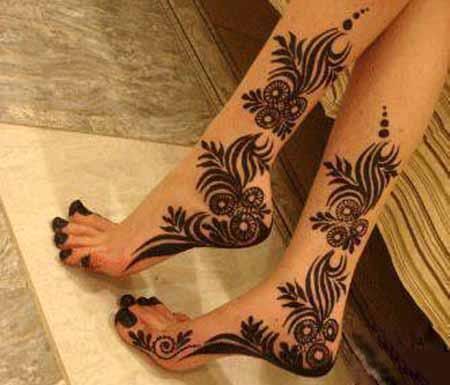Bridal Arabic Mehandi Designs (1) Biogarphy Photos Pictures Pics Images
source(google.com.pk)
We humans are fascinated with body decoration right since the beginning of life on earth. It is believed that early human cave dwellers braided seashells into their hair and wore bone necklaces. This art kept on improving with time and later Stone Age civilizations painted their hair and bodies with plant and mineral dyes. This colouring of bodies suggested group membership or rank which they belonged to. Gradually, symbolic body painting or colouring became a magical part of hunting rituals, religious festivals, and ceremonies.
Origin, history and tradition
The practice of henna body decoration dates back to Islam. Henna is thought to have first come into use in Egypt for coloring fingertips and finger nails, palms of hands, and soles of feet. One of the earliest documented uses of henna is found in the archeological evidence of Egyptian tombs in the valley of Nile. Mummies of Egyptian rulers and their families were prepared to enter the next world with henna-tinted fingernails. Hieroglyphics names henna as pouquer.
In Middle East, the leaves of the henna plant have been used for centuries as a beautification of the hands and feet. This has been done particularly as religious ritual or during some ceremony. In India, the women utilize it to beautify themselves before big occasions such as wedding and holidays. The traditional patterns mimic a lacy look, like gloves on the hands and arms, and very intricate and ravishing.
Henna's first roots in India are in question. During the reign of Augustus, Emperor of Rome (27 B.C.-A.D. 14), Egypt became an important trade centre for commerce between Rome and India. There are ancient murals in the Ajanta- Ellora caves near Mumabi (old Bombay) dated before A.D. 350 that, remarkably, show a princess of Patliputra reclining under a tree, half asleep, having her hands and feet painted with flowery henna designs. Historians mention that henna may have been brought to India along with Persian horses around A.D 712. What is known is that henna has been cultivated in Rajasthan since around 1476.
Bridal Arabic Mehandi Designs (1)Photos Pictures Pics Images
Bridal Arabic Mehandi Designs (1)Photos Pictures Pics Images
Bridal Arabic Mehandi Designs (1)Photos Pictures Pics Images
Bridal Arabic Mehandi Designs (1)Photos Pictures Pics Images
Bridal Arabic Mehandi Designs (1)Photos Pictures Pics Images
Bridal Arabic Mehandi Designs (1)Photos Pictures Pics Images
Bridal Arabic Mehandi Designs (1)Photos Pictures Pics Images
Bridal Arabic Mehandi Designs (1)Photos Pictures Pics Images
Bridal Arabic Mehandi Designs (1)Photos Pictures Pics Images
Bridal Arabic Mehandi Designs (1)Photos Pictures Pics Images
Bridal Arabic Mehandi Designs (1)Photos Pictures Pics Images
Bridal Arabic Mehandi Designs (1)Photos Pictures Pics Images












No comments:
Post a Comment